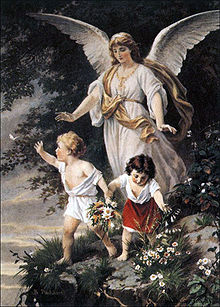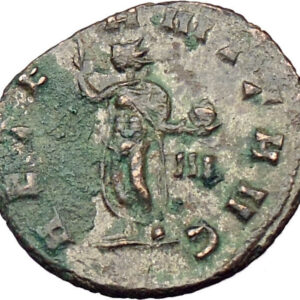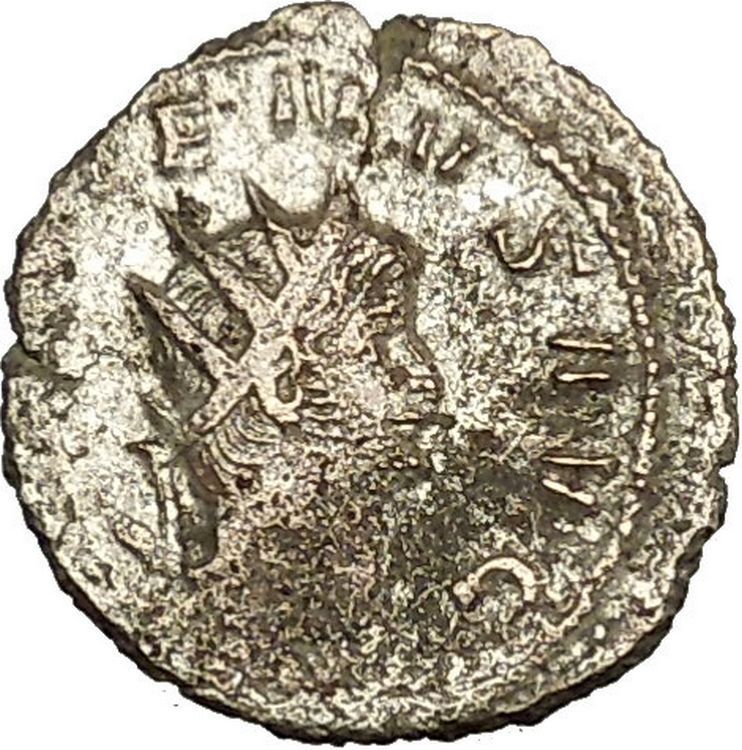|
Valentinian I – Roman Emperor: 364-375 A.D.
‘Last great western emperor’
Bronze AE3 17mm (2.17 grams) Siscia mint: 364-367 A.D.
Reference: RIC 7a.2 (IX, Siscia), LRBC 1277
DNVALENTINIANVSPFAVG – Diademed, draped and cuirassed bust right.
SECVRITASREIPVBLICAE Exe: */P/M/ΓSISC – Victory advancing left,
holding wreath and palm.
You are bidding on the exact item pictured, provided with a Certificate of Authenticity and Lifetime Guarantee of Authenticity.
 In ancient Roman religion, Victoria or Victory was the personified goddess of victory. She is the Roman equivalent of the Greek goddess Nike, and was associated with Bellona. She was adapted from the Sabine agricultural goddess Vacuna and had a temple on the Palatine Hill. The goddess Vica Pota was also sometimes identified with Victoria. In ancient Roman religion, Victoria or Victory was the personified goddess of victory. She is the Roman equivalent of the Greek goddess Nike, and was associated with Bellona. She was adapted from the Sabine agricultural goddess Vacuna and had a temple on the Palatine Hill. The goddess Vica Pota was also sometimes identified with Victoria.
Unlike the Greek Nike, the goddess Victoria (Latin for “victory”) was a major part of Roman society. Multiple temples were erected in her honor. When her statue was removed in 382 CE by Emperor Gratianus there was much anger in Rome. She was normally worshiped by triumphant generals returning from war.
Also unlike the Greek Nike, who was known for success in athletic games such as chariot races, Victoria was a symbol of victory over death and determined who would be successful during war.
Victoria appears widely on Roman coins, jewelry, architecture, and other arts. She is often seen with or in a chariot, as in the late 18th-century sculpture representing Victory in a quadriga on the Brandenburg Gate in Berlin, Germany; “Il Vittoriano” in Rome has two.
Winged figures, very often in pairs, representing victory and referred to as “victories”, were common in Roman official iconography, typically hovering high in a composition, and often filling spaces in spandrels or other gaps in architecture. These represent the spirit of victory rather than the goddess herself. They continued to appear after Christianization of the Empire, and slowly mutated into Christian angels.
 The symbolism of angels has been adopted from the ancient Roman goddess of victory by the early Christians. The goddess transformed into what is known by the Christians as angels via the Christianization of the Roman empire. This is evidenced by many coins still depicting victory, yet of the time period where Christianity was already the official religion of the Roman empire. She appears along with symbols such as a Christogram (also known as a Chi-Rho which is a monogram of Jesus Christ), Staurogram, and the cross, attributing to it’s Christian symbolism. The symbolism of angels has been adopted from the ancient Roman goddess of victory by the early Christians. The goddess transformed into what is known by the Christians as angels via the Christianization of the Roman empire. This is evidenced by many coins still depicting victory, yet of the time period where Christianity was already the official religion of the Roman empire. She appears along with symbols such as a Christogram (also known as a Chi-Rho which is a monogram of Jesus Christ), Staurogram, and the cross, attributing to it’s Christian symbolism.
An angel is a purely spiritual being found in various religions and mythologies. In Abrahamic religions and Zoroastrianism, angels are often depicted as benevolent celestial beings who act as intermediaries between God or Heaven and Earth, or as guardian spirits or a guiding influence. Other roles of angels include protecting and guiding human beings, and carrying out God’s tasks. The term “angel” has also been diversified to various notions of spirits or figures found in many other religious traditions. The theological study of angels is known as “angelology”. In art, angels are often depicted with bird-like wings on their back, a halo, robes and various forms of glowing light.
Valentinian I – Augustus: 364-375 A.D.
| 364-367 A.D. – Sole Reign | 367-375 A.D. Senior Augustus with Gratian |
Ruling in the East: Valens (364-378 A.D.) & Procopius (365-366 A.D.)
| Brother of Valens | Husband of Severa and Justina | Father (by Severa) of Gratian and (by Justina) of Valentinian II and Galla | Father-in-law of Theodosius I and Constantia (daughter of Constantius II) | Grandfather of Galla Placidia | Great-grandfather of Valentinian III and Honoria |
 Flavius Valentinianus, known in English as Valentinian I, (321 – November 17, 375) was Roman Emperor from 364 until his death. Valentinian is often referred to as the “last great western emperor”. Both he and his brother Emperor Valens were born at Cibalae (modern days Vinkovci, Croatia), in Pannonia, the sons of a successful general, Gratian the Elder. Flavius Valentinianus, known in English as Valentinian I, (321 – November 17, 375) was Roman Emperor from 364 until his death. Valentinian is often referred to as the “last great western emperor”. Both he and his brother Emperor Valens were born at Cibalae (modern days Vinkovci, Croatia), in Pannonia, the sons of a successful general, Gratian the Elder.
Life
He had been an officer who served under the emperors Julian and Jovian, and had risen high in the imperial service. Of robust frame and distinguished appearance, he possessed great courage and military capacity. After the death of Jovian, he was chosen emperor in his forty-third year by the officers of the army at Nicaea in Bithynia on February 26, 364, and shortly afterwards named his brother Valens colleague with him in the empire.
The two brothers, after passing through the chief cities of the neighbouring district, arranged the partition of the empire at Naissus (Nissa) in Upper Moesia. As Western Roman Emperor, Valentinian took Italia, Illyricum, Hispania, the Gauls, Britain and Africa, leaving to Eastern Roman Emperor Valens the eastern half of the Balkan peninsula, Greece, Aegyptus, Syria and Asia Minor as far as Persia. They were immediately confronted by the revolt of Procopius, a relative of the deceased Julian. Valens defeated his army at Thyatira in Lydia in 366, and Procopius was executed shortly afterwards.
During the short reign of Valentinian there were wars in Africa, in Germany, and in Britain, and Rome came into collision with barbarian peoples, specifically the Burgundians and the Saxons.
Valentinian’s chief work was guarding the frontiers and establishing military positions. Milan was at first his headquarters for settling the affairs of northern Italy. The following year (365) Valentinian was at Paris, and then at Reims, to direct the operations of his generals against the Alamanni. These people, defeated at Scarpona (Charpeigne) and Catelauni (Châlons-en-Champagne) by Jovinus, were driven back to the German bank of the Rhine, and checked for a while by a chain of military posts and fortresses. At the close of 367, however, they suddenly crossed the Rhine, attacked Moguntiacum (Mainz) and plundered the city. Valentinian attacked them at Solicinium (Sulz am Neckar, in the Neckar valley, or Schwetzingen) with a large army, and defeated them with great slaughter. But his own losses were so considerable that Valentinian abandoned the idea of following up his success.
Later, in 371, Valentinian made peace with their king, Macrian, who from that time remained a true friend of the Romans. The next three years he spent at Trier, which he chiefly made his headquarters, organizing the defence of the Rhine frontier, and personally superintending the construction of numerous forts.
During his reign the coasts of Gaul were harassed by the Saxon pirates, with whom the Picts and Scots of northern Britain joined hands, and ravaged the island from the Antonine Wall to the shores of Kent. In 368 Count Theodosius was sent to drive back the invaders; in this he was completely successful, and established a new British province, called Valentia in honour of the emperor.
In Africa, Firmus raised the standard of revolt, being joined by the provincials, who had been rendered desperate by the cruelty and extortions of Comes Romanus, the military governor. The services of Theodosius were again requisitioned. He landed in Africa with a small band of veterans, and Firmus, to avoid being taken prisoner, committed suicide.
In 374, the Quadi, a Germanic tribe in what is now Moravia and Slovakia, resenting the erection of Roman forts to the north of the Danube in what they considered to be their own territory, and further exasperated by the treacherous murder of their king, Gabinius, crossed the river and laid waste the province of Pannonia. The emperor in April, 375 entered Illyricum with a powerful army. But during an audience to an embassy from the Quadi at Brigetio on the Danube (near today Komárno in Slovakia), Valentinian suffered a burst blood vessel in the skull while angrily yelling at the people gathered. This injury resulted in his death on November 17, 375.
Reputation
A.H.M. Jones writes that though he was “less of a boor” than his chief rival for election to the imperial throne, “he was of a violent and brutal temper, and not only uncultivated himself, but hostile to cultivated persons”, as Ammianus tells us, ‘he hated the well-dressed and educated and wealthy and well-born’. He was, however, an able soldier and a conscientious administrator, and took an interest in the welfare of the humbler classes, from which his father had risen. Unfortunately his good intentions were often frustrated by a bad choice of ministers, and an obstinate belief in their merits despite all evidence to the contrary.”[2] According to the Encyclopædia Britannica 1911, he was a founder of schools, and provided medical attendance for the poor of Rome, by appointing a physician for each of the fourteen districts of the city.
Valentinian was a Christian but permitted liberal religious freedom to all his subjects, proscribing only some forms of rituals such as particular types of sacrifices, and banning the practice of magic. Against all abuses, both civil and ecclesiastical (excepting, of course, his own excesses), Valentinian steadily set his face, even against the increasing wealth and worldliness of the clergy. His chief flaw was his temper, which at times was frightful, and showed itself in its full fierceness in the punishment of persons accused of witchcraft, some kinds of fortune-telling or magical practices.”
|





 In ancient Roman religion, Victoria or Victory was the personified goddess of victory. She is the Roman equivalent of the Greek goddess Nike, and was associated with Bellona. She was adapted from the Sabine agricultural goddess Vacuna and had a temple on the Palatine Hill. The goddess Vica Pota was also sometimes identified with Victoria.
In ancient Roman religion, Victoria or Victory was the personified goddess of victory. She is the Roman equivalent of the Greek goddess Nike, and was associated with Bellona. She was adapted from the Sabine agricultural goddess Vacuna and had a temple on the Palatine Hill. The goddess Vica Pota was also sometimes identified with Victoria. The symbolism of angels has been adopted from the ancient Roman goddess of victory by the early Christians. The goddess transformed into what is known by the Christians as angels via the Christianization of the Roman empire. This is evidenced by many coins still depicting victory, yet of the time period where Christianity was already the official religion of the Roman empire. She appears along with symbols such as a Christogram (also known as a Chi-Rho which is a monogram of Jesus Christ), Staurogram, and the cross, attributing to it’s Christian symbolism.
The symbolism of angels has been adopted from the ancient Roman goddess of victory by the early Christians. The goddess transformed into what is known by the Christians as angels via the Christianization of the Roman empire. This is evidenced by many coins still depicting victory, yet of the time period where Christianity was already the official religion of the Roman empire. She appears along with symbols such as a Christogram (also known as a Chi-Rho which is a monogram of Jesus Christ), Staurogram, and the cross, attributing to it’s Christian symbolism.  Flavius Valentinianus, known in English as Valentinian I, (321 – November 17, 375) was Roman Emperor from 364 until his death. Valentinian is often referred to as the “last great western emperor”. Both he and his brother Emperor Valens were born at Cibalae (modern days Vinkovci, Croatia), in Pannonia, the sons of a successful general, Gratian the Elder.
Flavius Valentinianus, known in English as Valentinian I, (321 – November 17, 375) was Roman Emperor from 364 until his death. Valentinian is often referred to as the “last great western emperor”. Both he and his brother Emperor Valens were born at Cibalae (modern days Vinkovci, Croatia), in Pannonia, the sons of a successful general, Gratian the Elder. 




